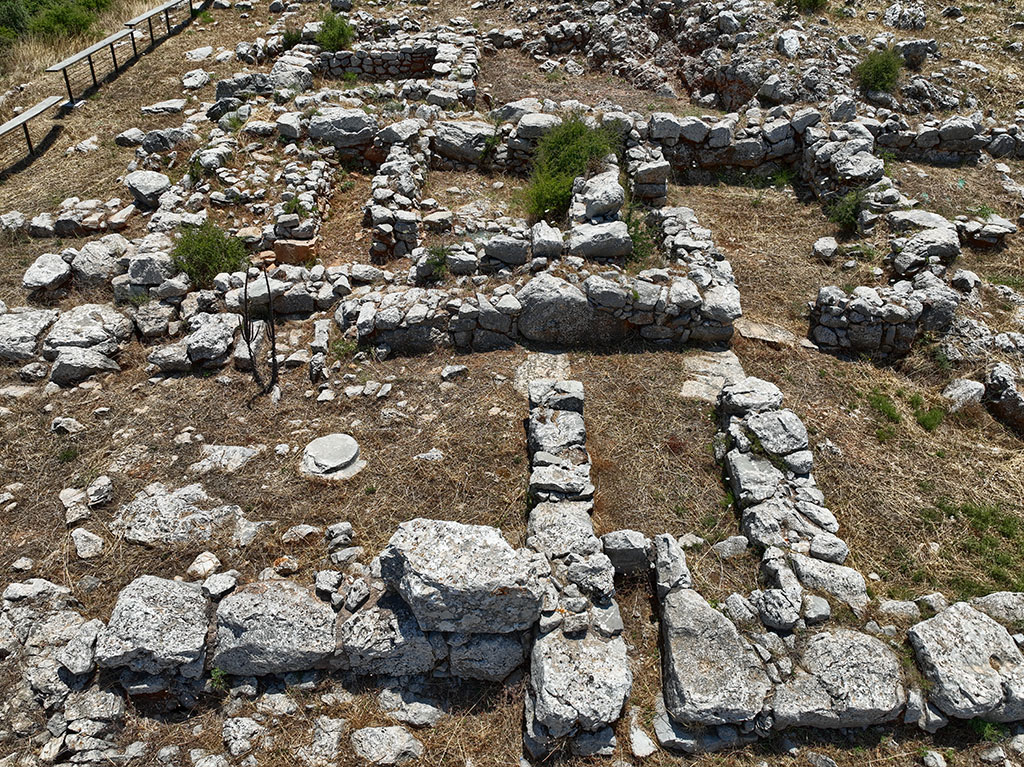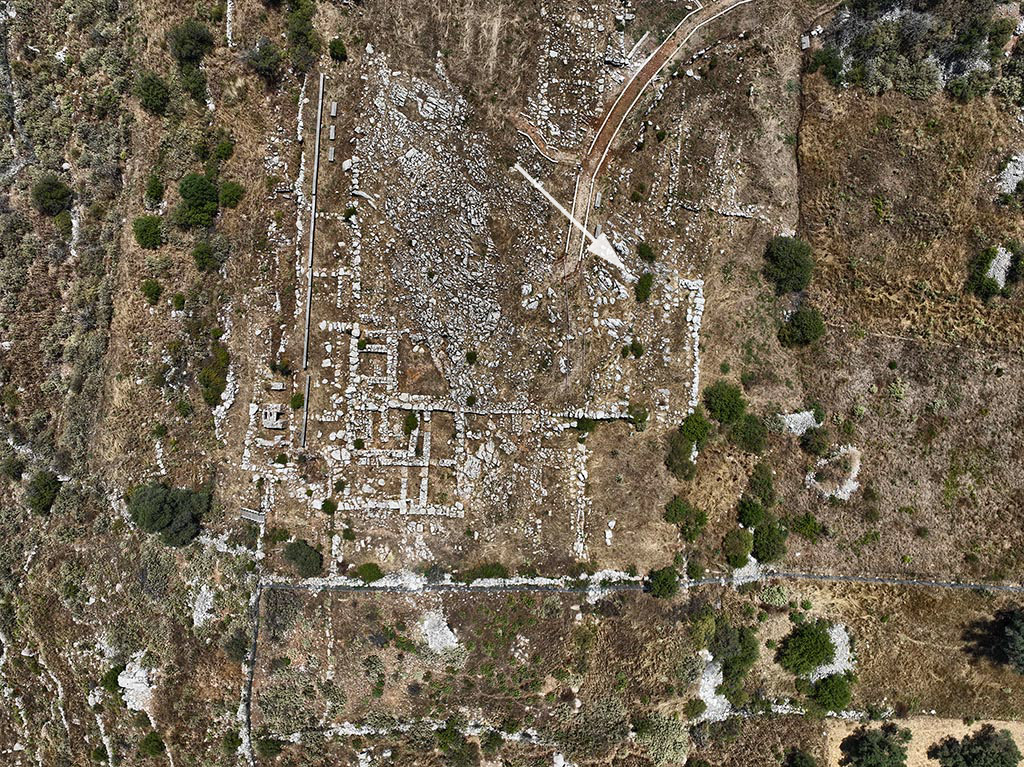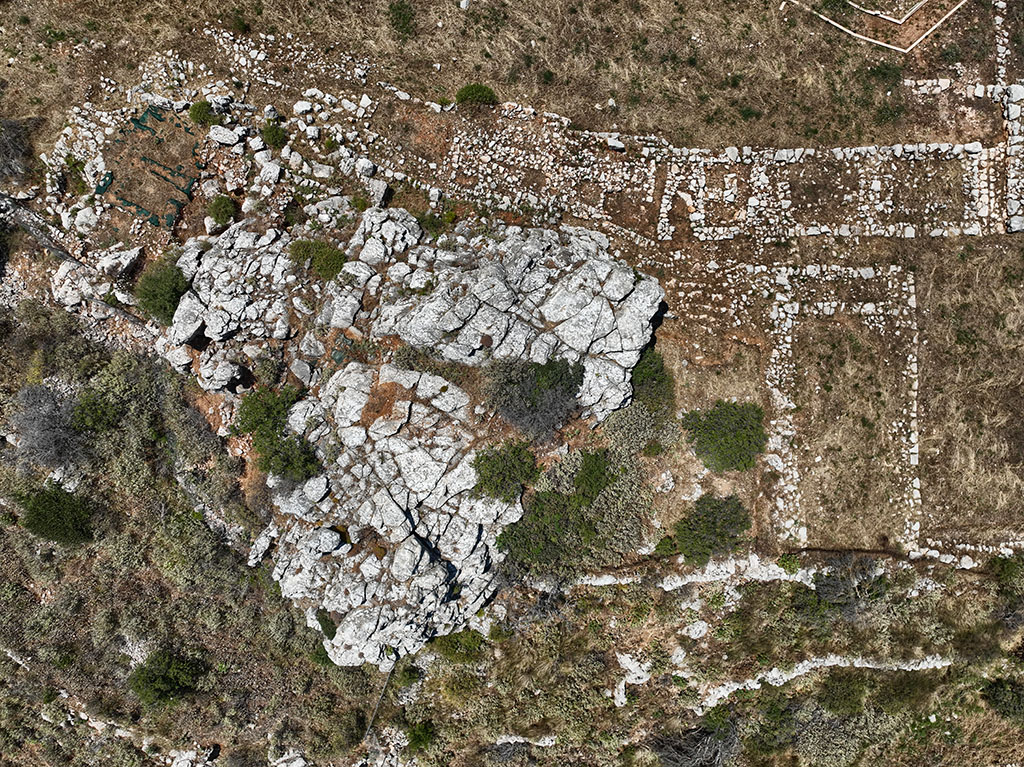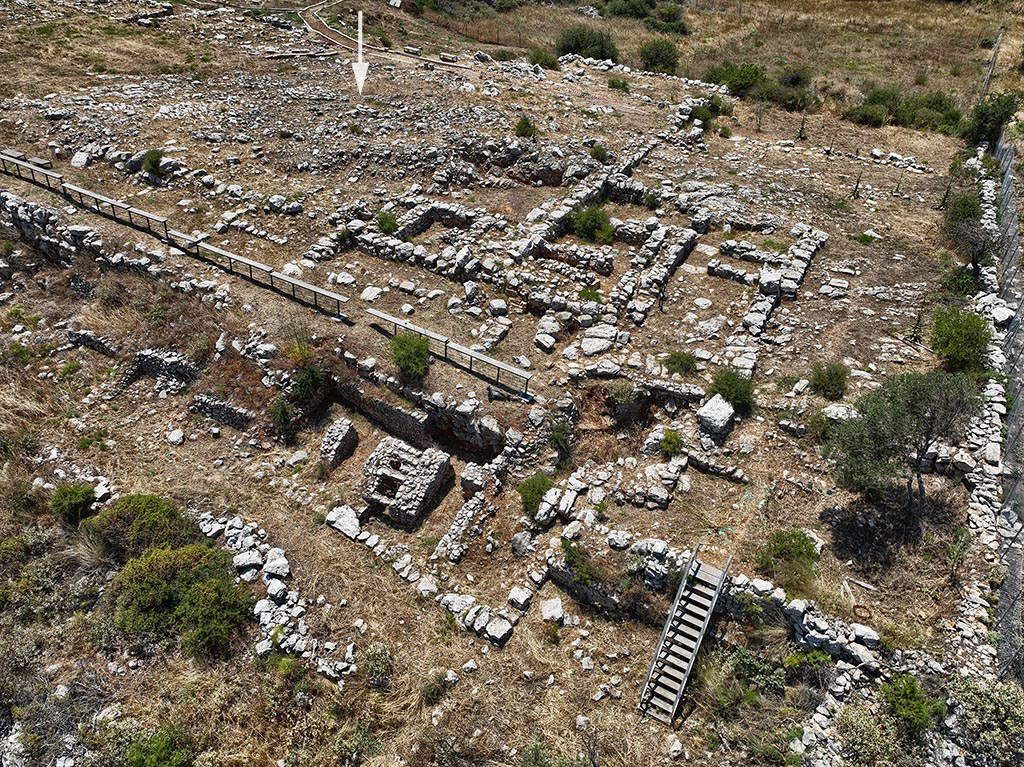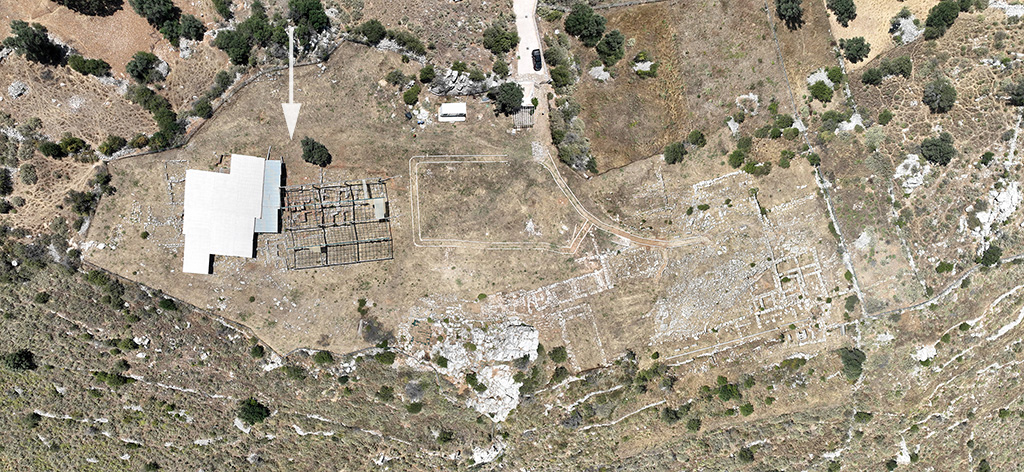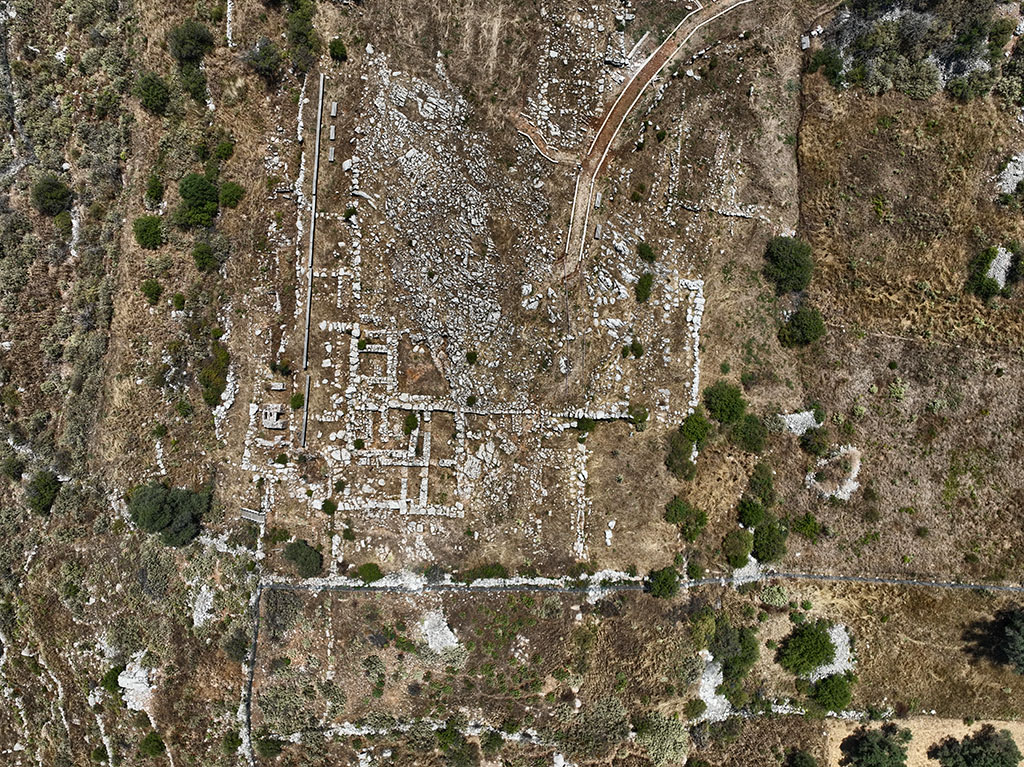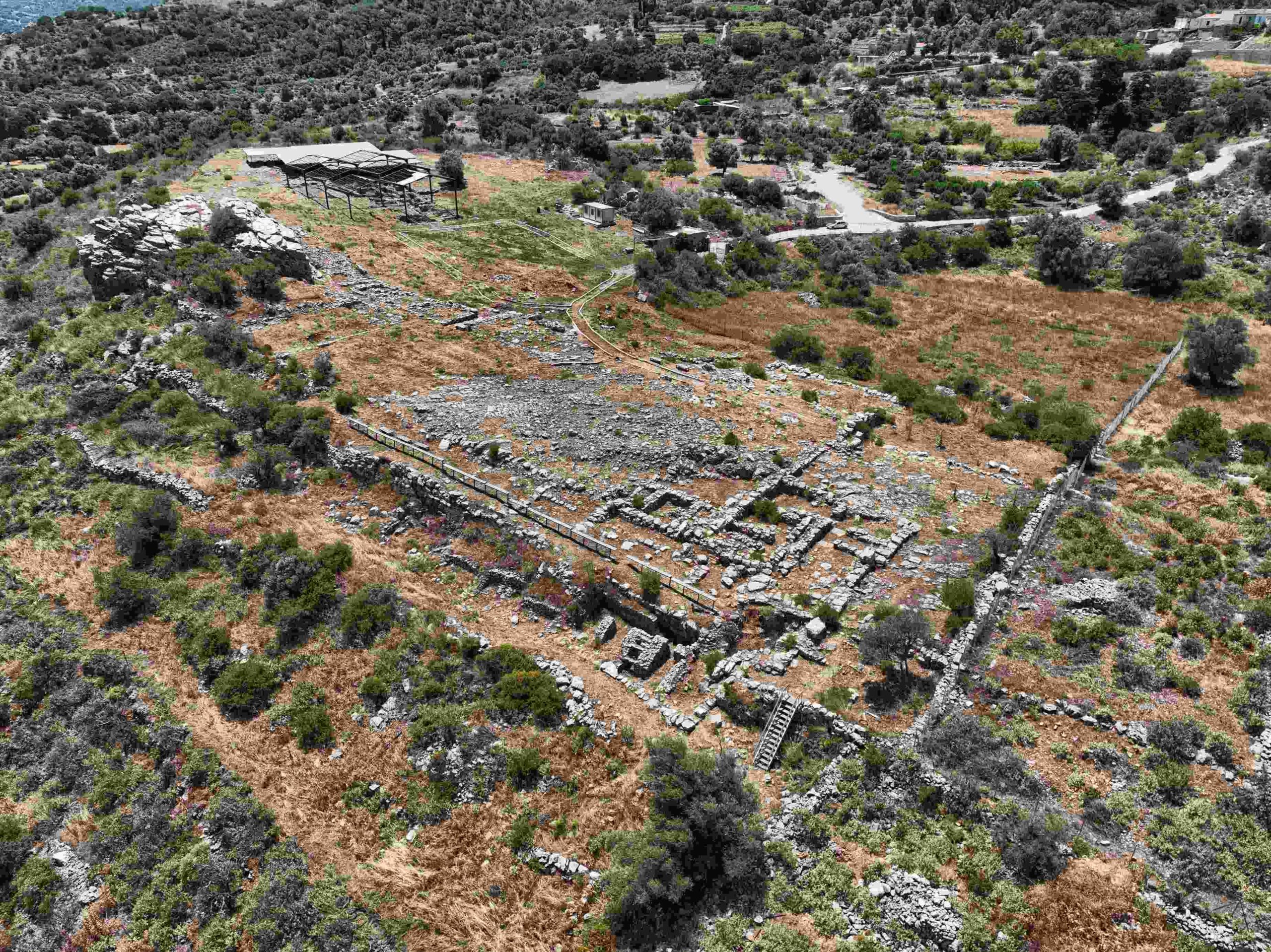
Aerial photograph of the archaeological site.
Minoan palatial centre at Monastiraki
The archaeological site of Monastiraki extends on the top and the slopes of a low hill in the Amari valley, between Mount Idi and Mount Kedros. During the Second World War, excavations of the site were carried out by German archaeologists-officers. The site was systematically excavated for the first time in 1980 by the Honorary Director R.U. of Heraklio Dr Athanasia Kanda. In 1982-1984, an excavation survey was carried out by a Greek-Italian archaeological mission under the direction of the Honorary General Director of Antiquities of the Ministry of Culture, Mr. Yannis Tzedakis and the professor of the University of Naples, Federico II, Louis Godart. The excavation was continued by the Honorary Director R.U. Heraklion Dr Athanasia Kanda.
The long-term systematic excavation research brought to light an extensive settlement of the Protopalatial period, which dates back to the MMI-MMIIV period (c. 2000-1700 BC) and has all the characteristics of a palatial center of the time, such as monumental architecture, urban planning organization, archives of sealings, extensive workshops and storerooms, official living districts, worship spaces and collective gathering.
Three building complexes have been excavated to date in Monastiraki.
The Southern complex was initially excavated by the Greek-Italian expedition. It consists of several rooms. The first archive of sealings was found in a room next to the south entrance of the complex. Access to this room was via a ramp. A road system has also been revealed. A significant find in this complex is a clay model of a shrine.
The Eastern complex included 90 rooms. The ground floor housed storerooms, workshop areas, and places of worship, while on the first floor, there were living quarters and administrative districts. Open spaces and kitchens have been revealed to the north of the eastern complex. The Second archive of sealings, consisting of more than 900 sealings, was found in two rooms on the first floor. A ramp road that led to the top of the hill and intersected with other roads in an N-S axis has been traced in the eastern complex.
German military officials/archaeologists initially excavated the Western complex during the Second World War and then by the Honorary Director R.U. of Heraklio, Dr Athanasia Kanda. The excavation brought to light a monumental building with a megalithic facade with recesses, an area of ritual character with a pillar at its center, and an entrance with stone pilasters. A third archive of sealings was found in the western complex. Large terraces and two courtyards were discovered to the north and south of the complex.
A central courtyard was on the large, rectangular plateau at the top of the hill. The courtyards are a typical element of the Minoan palaces. It was accessed from the SW and NE. From the Central Court, a corridor led to Kokkinos Harakas, the rock that roughly dominates the center of the site. At the base of the rock, there are traces of a stepped access, while a significant shrine complex was excavated on its eastern side.
The final destruction of the settlement came from an earthquake and fire at the end of the Protopalatial period (MMIIB) around 1700 BC.
Bibliography
Minoan palatial centre at Monastiraki
The archaeological site of Monastiraki extends on the top and the slopes of a low hill in the Amari valley, between Mount Idi and Mount Kedros. During the Second World War, excavations of the site were carried out by German archaeologists-officers. The site was systematically excavated for the first time in 1980 by the Honorary Director R.U. of Heraklio Dr Athanasia Kanda. In 1982-1984, an excavation survey was carried out by a Greek-Italian archaeological mission under the direction of the Honorary General Director of Antiquities of the Ministry of Culture, Mr. Yannis Tzedakis and the professor of the University of Naples, Federico II, Louis Godart. The excavation was continued by the Honorary Director R.U. Heraklion Dr Athanasia Kanda.
The long-term systematic excavation research brought to light an extensive settlement of the Protopalatial period, which dates back to the MMI-MMIIV period (c. 2000-1700 BC) and has all the characteristics of a palatial center of the time, such as monumental architecture, urban planning organization, archives of sealings, extensive workshops and storerooms, official living districts, worship spaces and collective gathering.
Three building complexes have been excavated to date in Monastiraki.
The Southern complex was initially excavated by the Greek-Italian expedition. It consists of several rooms. The first archive of sealings was found in a room next to the south entrance of the complex. Access to this room was via a ramp. A road system has also been revealed. A significant find in this complex is a clay model of a shrine.
The Eastern complex included 90 rooms. The ground floor housed storerooms, workshop areas, and places of worship, while on the first floor, there were living quarters and administrative districts. Open spaces and kitchens have been revealed to the north of the eastern complex. The Second archive of sealings, consisting of more than 900 sealings, was found in two rooms on the first floor. A ramp road that led to the top of the hill and intersected with other roads in an N-S axis has been traced in the eastern complex.
German military officials/archaeologists initially excavated the Western complex during the Second World War and then by the Honorary Director R.U. of Heraklio, Dr Athanasia Kanda. The excavation brought to light a monumental building with a megalithic facade with recesses, an area of ritual character with a pillar at its center, and an entrance with stone pilasters. A third archive of sealings was found in the western complex. Large terraces and two courtyards were discovered to the north and south of the complex.
A central courtyard was on the large, rectangular plateau at the top of the hill. The courtyards are a typical element of the Minoan palaces. It was accessed from the SW and NE. From the Central Court, a corridor led to Kokkinos Harakas, the rock that roughly dominates the center of the site. At the base of the rock, there are traces of a stepped access, while a significant shrine complex was excavated on its eastern side.
The final destruction of the settlement came from an earthquake and fire at the end of the Protopalatial period (MMIIB) around 1700 BC.
Bibliography
Kanta, A., & Tzigounaki, A. (1996). La Bureaucratie palatiale: La naissance et Evolution d’ Un System de Pouvoir en Egee. Atti e Memorie Del Secondo Congresso Di Micenologia. Incunabula Graeca, Vol. XCVIII, 2, Roma.
Godart, L., Kanta, A., & Tzigounaki, A. (2000). Les scellés de Monastiraki. Minoisch-Mykenische Glyptik: Stil, Ikonographie, Funktion. In Pini, I. (eds), V. Internationales Siegel-Symposium Marburg, 23-25 September 1999, Berlin, pp. 95-96.
Kanta, A., & Tzigounaki, A. (2001). The Character of the Minoan Goddess. New Evidence From the Area of Amari. In Potnia, Deities and Religion in the Aegean Bronze Age. Proceedings of the 8th International Aegean Conference, Göteborg, Göteborg University, Aegaeum, Vol. 22, pp. 12-15.
Kanta, A., & Tzigounaki, A. (2001). Clay model of a two- storey shrine. In Α.Karetsou, M. Andreadaki- Vlazaki and N. Papadakis (eds), Crete – Egypt. Three Thousand Years of Cultural Links. Herakleion- Cairo, pp. 63- 64.
Kanta, A., & Marazzi, M. (2006). Monastiraki I: Monastiraki, a palatial Minoan center in the valley of Amari. Napoli- Heraklion.
Kanta, A. (2008). A Minoan Palace on the slopes of Mount Ida. CEM Università Degli Studi Suor Orsola Banincasa. Un Palazzo Minoico Alle Falde Del Monte Ida. Studio Preliminare Di Un Parco Archeologico a Monastiraki Nella Valle Di Amari–Creta. Napoli.
Kanta, A. (2012). Monastiraki ΙΙΑ: Monastiraki, Excavations of a Minoan Palatial Centre in the Amari Valley. The Archive Building and Associated Finds. Heraklion.
Kanta, A., & Marazzi, M. (2013). Monastiraki III: Studies of the Protopalatial Architectural Remains in Monastiraki (Amari Valley). The East Quarter of Monastiraki (Mon. East). Napoli- Heraklion.

